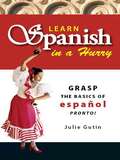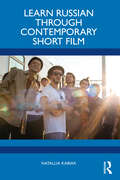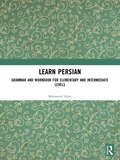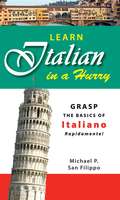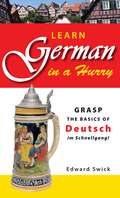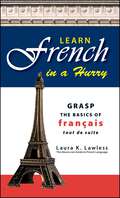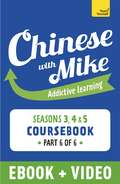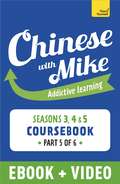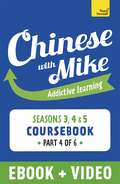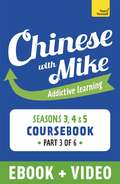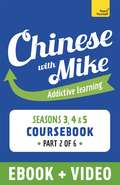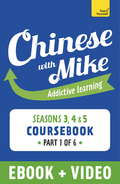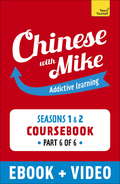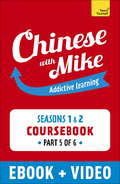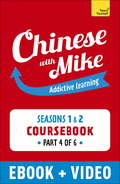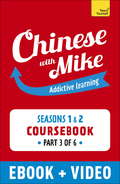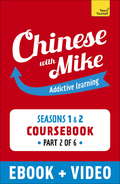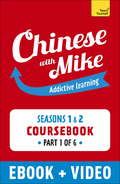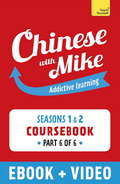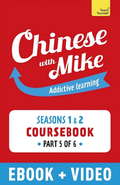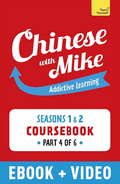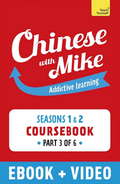- Table View
- List View
Learn Spanish In A Hurry: Grasp the Basics of Espanol Pronto!
by Julie GutinThe Ultimate Guide to Learning Spanish ASAP!Is your Spanish vocabulary limited to "Hola" and "Adios"? Don't know the difference between "pero" and "para"? Whether you are traveling to a Spanish-speaking country or just want a jumpstart to learning Spanish for a class, you need to learn how to "hablar español"--and fast! Learn Spanish in a Hurry is your ideal pocket-sized primer to learning this essential language, with such quick lessons as Basic survival Spanish, Grammar exercises and sentence structuring, Verb conjugation and tables, and Written Spanish.Ideal for those who speak limited or no Spanish whatsoever, Learn Spanish in a Hurry makes mastering Spanish basics a snap!
Learn Spanish In A Hurry
by Julie GutinIs your Spanish vocabulary limited to "Hola" and "Adios"? Don't know the difference between "pero" and "para"? Whether you are traveling to a Spanish-speaking country or just want a jumpstart to learning Spanish for a class, you need to learn how to "hablar espanol"--and fast! Learn Spanish in a Hurry is your ideal pocket-sized primer to learning this essential language, with such quick lessons as 'Basic survival Spanish'; grammar exercises and sentence structuring; verb conjugation and tables; and written Spanish. Ideal for those who speak limited or no Spanish whatsoever, Learn Spanish in a Hurry makes mastering Spanish basics a snap!
Learn Russian through Contemporary Short Film
by Natallia KabiakLearn Russian through Contemporary Short Film is a book with 12 modules, based on modern Russian and Kazakh short films released between 2014–2022.The films immerse students in various aspects of culture and daily life. This greatly assists the development of advanced-level Russian proficiency in listening, speaking, reading and writing.The inquiry-based approach provides active stimuli for productive discussion. The book is aimed at the High-Intermediate to Advanced levels (B1 – C1 in the CEFR). Each book chapter includes a series of activities offering engaging frameworks in which students can advance all four language skills. By utilizing short films as teaching materials, instructors can deliver engaging learning modules within limited timeframes. The book’s modular approach to structure offers flexibility for the instructors, who can choose films and exercises that best suit their particular pedagogical goals. The book includes keys to exercises, making it suitable for self-study. The book is aimed at university students learning Russian as a foreign language at the High-Intermediate level or above, Russian students at vocational centers, high school students sitting Russian as a second language exam, or self-directed Russian learners who wish to enrich both their command of the language itself and their insight into Russian daily life and contemporary cinema.
Learn Persian: Grammar and Workbook for Elementary and Intermediate Levels
by Mahmood AlamLearn Persian has a step-by-step organized and structured framework of modern Persian words; grammar, short syntactical phrases and idiomatic expressions. Persian has a lot of common words and sounds from Arabic and Urdu; this work highlights vowels and consonants that are covered in the formation of words and sounds with apt precision. The special feature of this book is its simplicity, yet meaningful and comprehensiveness for the study of the language. This should be a good source book for new learners, as well as for those who want to explore the harmony and flair of Persian. It would undoubtedly open doors to a Persian heritage as much as it slowly trains the eager learner in spoken Persian as well. Learn Persian will interest both learners and experts, and an excellent experience of coming across Persian as an interesting living language.
Learn Italian in a Hurry: Grasp the Basics of Italian Rapidamente!
by Michael P San FilippoThe Ultimate Guide to Learning Italian ASAP!You know how to order your favorite "ravioli" or "vino"--but that can only get you so far. If you are planning to travel to an Italian-speaking country or want a jumpstart on on how to "parlare" for a class, Learn Italian in a Hurry is your ideal pocket-sized primer to learn this beautiful language, with sections on Commonly used Italian phrases (days of the week, letter, numbers), Pronunciations and conjugations, Grammar and sentence construction, Useful words and terms, and Helpful Italian-English and English-Italian dictionaries.Complete with easy-to-read tables, pronunciation guides throughout, and even a must-visit list of Italian cities, Learn Italian in a Hurry is your key to learning Italian "rapidamente"!
Learn Italian in a Hurry
by Michael P San FelippoYou know how to order your favorite ravioli or vino--but that can only get you so far. If you are planning to travel to an Italian-speaking country or want a jumpstart on how to parlarle for a class, Learn Italian in a Hurry is your ideal pocket-sized primer to learning this beautiful language, with sections on: Commonly used Italian phrases (days of the week, numbers, letters); Pronunciations and conjugations; Grammar and sentence construction; Useful words and terms; Helpful Italian-English and English-Italian dictionaries; and more. Complete with easy-to-read tables, pronunciations guides throughout, and even a must-visit list of Italian cities, Learn Italian in a Hurry is your key to learning Italian rapidamente!
Learn German in a Hurry: Grasp the Basics of Deutsch im Schnellgang!
by Edward SwickThe Ultimate Guide to Learning German, im Schnellgang!Sure, you may know your bratwurst from your wiener schnitzel--but that will only get you so far if you're planning a trip to a German-speaking country, or want to get ahead in your German 101 class. With this ideal pocket-sized primer you can leave the brat behind and learn how to master the basics of German in no time!Learn German in a Hurry teaches you all you need, and offers you Commonly used German phrases (days of the week, numbers, letters), Pronunciations and conjugations, Grammar and sentence construction, Useful words and terms, and Helpful German-English and English-German dictionaries.Complete with easy-to-read tables and pronunciation guides, Learn German in a Hurry is your key to learning "die deutsche" before you know it!
Learn German in a Hurry
by Edward SwickYou may recognize the distinct sound of the German language when you hear it-but that's not enough if you're planning a trip to a German-speaking country, is it? What if you want to get a head start for your first language class? Wouldn't it be nice to be able to talk to Grandpa on the phone-in his native tongue? With this ideal pocket-sized primer, now you can do all of these things! Learn German in a Hurry teaches you all you need, and offers you: Commonly used German phrases (days of the week, numbers, letters); Pronunciations and conjugations; Grammar and sentence construction; Useful words and terms; Helpful German-English and English-German dictionaries; and more. Complete with easy-to-read tables and pronunciations guides, Learn German in a Hurry is your key to learning die deutsche before you know it!
Learn French In A Hurry: Grasp the Basics of Francais Tout De Suite
by Laura LawlessSure, you can blurt out Merci! and Oui! Oui! and Garcon! as well as the next tourist, but in truth your French lacks a certain je ne sais quoi. That just won't do if you're touring the City of Light or sunning in Tahiti or ordering a la carte in a Montreal cafe. Whether you're traveling to a French-speaking country or learning French for business, this pocket-sized primer is your passeport to one of the world's most beautiful - and useful - languages.Learn French in a Hurry features:Common French phrases (days of the week, numbers, letters)Pronunciation and conjugation tips and tricksGrammar made easyUseful words and termsHelpful French-English and English-French dictionariesWith Learn French in a Hurry, you'll master le francais right away!
Learn Chinese with Mike Advanced Beginner to Intermediate Coursebook Seasons 3, 4 & 5: Enhanced Edition Part 6
by Mike Hainzinger"It is definitely new, and it definitely works." -Dr. Licheng Gu, Program Director, African & Asian Languages, Northwestern University What do I get when I learn Chinese with Mike? This ebook contains 10 video-based lessons and is part four of a series of six. It features audio and visual learning material and works best on tablets and smartphones. Addictive learning Mike Laoshi (Teacher Mike) will astound you with his unparalleled ability to make learning Mandarin Chinese fun and easy. Be warned, his teaching style is highly addictive, so if you have a family, career or social life, you may want to put those on hold for a little while. Why Chinese with Mike? Chinese with Mike is 100% new and breaks with traditional Chinese curricula. Mike's humour, mixed with his logical, step-by-step approach shields learners from the unnecessary complexities of Mandarin Chinese. Through a blend of short and highly addictive video lessons, you'll acquire essential Chinese with confidence. More importantly, you get a little one-on-one time with Mike, as he makes learning Chinese ridiculously easy-and fun! What will I learn? Season 3 Learn to tell people the milk is in the refrigerator and your dirty clothes are under the bed. You'll also learn about jobs, dreams and measure words. Season 4 You'll learn some new adjectives, adverbs, prepositions and conjunctions and best of all, you'll get to watch Mike Laoshi's ballet lesson and retirement press conference. Season 5 This was never meant to be, but Mike Laoshi was lured out of retirement. You'll learn how to make comparisons (I am smarter than you) and use superlatives (This is the best Chinese book ever!). Also talk about the past and the future and use transitions to put events in sequence. Why will learning Chinese be a breeze? · Mike builds confidence through his logical step-by-step design of the course · Mike explains pronunciation with clear, familiar examples · Mike adds interesting facts about the intricacies of language · Mike includes lots of cultural tidbits · Mike recognizes and explains thoroughly troublesome areas · Mike uses native speakers to help you with listening and speaking Chinese with Mike is suitable for classroom, self-study or home schooling. Praise for Mike The coolest Chinese teacher out there. Totally rad!! confusedlaowai.com Like a rock star teacher. Excellent for beginners. Entertaining too! socialmandarin.com As an instructor, I have found Prof. Hainzinger's teaching material was very practical; it was very easy to be inserted into our classroom activities because of its fragmented structural style, and its companying video files. In addition, the students really appreciated the lively style of the text, as well the vivid video contributions. Yuxiang Liu Lecturer in Chinese, EALC The University of Chicago
Learn Chinese with Mike Advanced Beginner to Intermediate Coursebook Seasons 3, 4 & 5: Enhanced Edition Part 5
by Mike Hainzinger"It is definitely new, and it definitely works." -Dr. Licheng Gu, Program Director, African & Asian Languages, Northwestern University What do I get when I learn Chinese with Mike? This ebook contains 10 video-based lessons and is part five of a series of six. It features audio and visual learning material and works best on tablets and smartphones. Addictive learning Mike Laoshi (Teacher Mike) will astound you with his unparalleled ability to make learning Mandarin Chinese fun and easy. Be warned, his teaching style is highly addictive, so if you have a family, career or social life, you may want to put those on hold for a little while. Why Chinese with Mike? Chinese with Mike is 100% new and breaks with traditional Chinese curricula. Mike's humour, mixed with his logical, step-by-step approach shields learners from the unnecessary complexities of Mandarin Chinese. Through a blend of short and highly addictive video lessons, you'll acquire essential Chinese with confidence. More importantly, you get a little one-on-one time with Mike, as he makes learning Chinese ridiculously easy-and fun! What will I learn? Season 3 Learn to tell people the milk is in the refrigerator and your dirty clothes are under the bed. You'll also learn about jobs, dreams and measure words. Season 4 You'll learn some new adjectives, adverbs, prepositions and conjunctions and best of all, you'll get to watch Mike Laoshi's ballet lesson and retirement press conference. Season 5 This was never meant to be, but Mike Laoshi was lured out of retirement. You'll learn how to make comparisons (I am smarter than you) and use superlatives (This is the best Chinese book ever!). Also talk about the past and the future and use transitions to put events in sequence. Why will learning Chinese be a breeze? · Mike builds confidence through his logical step-by-step design of the course · Mike explains pronunciation with clear, familiar examples · Mike adds interesting facts about the intricacies of language · Mike includes lots of cultural tidbits · Mike recognizes and explains thoroughly troublesome areas · Mike uses native speakers to help you with listening and speaking Chinese with Mike is suitable for classroom, self-study or home schooling. Praise for Mike The coolest Chinese teacher out there. Totally rad!! confusedlaowai.com Like a rock star teacher. Excellent for beginners. Entertaining too! socialmandarin.com As an instructor, I have found Prof. Hainzinger's teaching material was very practical; it was very easy to be inserted into our classroom activities because of its fragmented structural style, and its companying video files. In addition, the students really appreciated the lively style of the text, as well the vivid video contributions. Yuxiang Liu Lecturer in Chinese, EALC The University of Chicago
Learn Chinese with Mike Advanced Beginner to Intermediate Coursebook Seasons 3, 4 & 5: Enhanced Edition Part 4
by Mike Hainzinger"It is definitely new, and it definitely works." -Dr. Licheng Gu, Program Director, African & Asian Languages, Northwestern University What do I get when I learn Chinese with Mike? This ebook contains 10 video-based lessons and is part four of a series of six. It features audio and visual learning material and works best on tablets and smartphones. Addictive learning Mike Laoshi (Teacher Mike) will astound you with his unparalleled ability to make learning Mandarin Chinese fun and easy. Be warned, his teaching style is highly addictive, so if you have a family, career or social life, you may want to put those on hold for a little while. Why Chinese with Mike? Chinese with Mike is 100% new and breaks with traditional Chinese curricula. Mike's humour, mixed with his logical, step-by-step approach shields learners from the unnecessary complexities of Mandarin Chinese. Through a blend of short and highly addictive video lessons, you'll acquire essential Chinese with confidence. More importantly, you get a little one-on-one time with Mike, as he makes learning Chinese ridiculously easy-and fun! What will I learn? Season 3 Learn to tell people the milk is in the refrigerator and your dirty clothes are under the bed. You'll also learn about jobs, dreams and measure words. Season 4 You'll learn some new adjectives, adverbs, prepositions and conjunctions and best of all, you'll get to watch Mike Laoshi's ballet lesson and retirement press conference. Season 5 This was never meant to be, but Mike Laoshi was lured out of retirement. You'll learn how to make comparisons (I am smarter than you) and use superlatives (This is the best Chinese book ever!). Also talk about the past and the future and use transitions to put events in sequence. Why will learning Chinese be a breeze? · Mike builds confidence through his logical step-by-step design of the course · Mike explains pronunciation with clear, familiar examples · Mike adds interesting facts about the intricacies of language · Mike includes lots of cultural tidbits · Mike recognizes and explains thoroughly troublesome areas · Mike uses native speakers to help you with listening and speaking Chinese with Mike is suitable for classroom, self-study or home schooling. Praise for Mike The coolest Chinese teacher out there. Totally rad!! confusedlaowai.com Like a rock star teacher. Excellent for beginners. Entertaining too! socialmandarin.com As an instructor, I have found Prof. Hainzinger's teaching material was very practical; it was very easy to be inserted into our classroom activities because of its fragmented structural style, and its companying video files. In addition, the students really appreciated the lively style of the text, as well the vivid video contributions. Yuxiang Liu Lecturer in Chinese, EALC The University of Chicago
Learn Chinese with Mike Advanced Beginner to Intermediate Coursebook Seasons 3, 4 & 5: Enhanced Edition Part 3
by Mike Hainzinger"It is definitely new, and it definitely works." -Dr. Licheng Gu, Program Director, African & Asian Languages, Northwestern University What do I get when I learn Chinese with Mike? This ebook contains 10 video-based lessons and is part four of a series of six. It features audio and visual learning material and works best on tablets and smartphones. Addictive learning Mike Laoshi (Teacher Mike) will astound you with his unparalleled ability to make learning Mandarin Chinese fun and easy. Be warned, his teaching style is highly addictive, so if you have a family, career or social life, you may want to put those on hold for a little while. Why Chinese with Mike? Chinese with Mike is 100% new and breaks with traditional Chinese curricula. Mike's humour, mixed with his logical, step-by-step approach shields learners from the unnecessary complexities of Mandarin Chinese. Through a blend of short and highly addictive video lessons, you'll acquire essential Chinese with confidence. More importantly, you get a little one-on-one time with Mike, as he makes learning Chinese ridiculously easy-and fun! What will I learn? Season 3 Learn to tell people the milk is in the refrigerator and your dirty clothes are under the bed. You'll also learn about jobs, dreams and measure words. Season 4 You'll learn some new adjectives, adverbs, prepositions and conjunctions and best of all, you'll get to watch Mike Laoshi's ballet lesson and retirement press conference. Season 5 This was never meant to be, but Mike Laoshi was lured out of retirement. You'll learn how to make comparisons (I am smarter than you) and use superlatives (This is the best Chinese book ever!). Also talk about the past and the future and use transitions to put events in sequence. Why will learning Chinese be a breeze? · Mike builds confidence through his logical step-by-step design of the course · Mike explains pronunciation with clear, familiar examples · Mike adds interesting facts about the intricacies of language · Mike includes lots of cultural tidbits · Mike recognizes and explains thoroughly troublesome areas · Mike uses native speakers to help you with listening and speaking Chinese with Mike is suitable for classroom, self-study or home schooling. Praise for Mike The coolest Chinese teacher out there. Totally rad!! confusedlaowai.com Like a rock star teacher. Excellent for beginners. Entertaining too! socialmandarin.com As an instructor, I have found Prof. Hainzinger's teaching material was very practical; it was very easy to be inserted into our classroom activities because of its fragmented structural style, and its companying video files. In addition, the students really appreciated the lively style of the text, as well the vivid video contributions. Yuxiang Liu Lecturer in Chinese, EALC The University of Chicago
Learn Chinese with Mike Advanced Beginner to Intermediate Coursebook Seasons 3, 4 & 5: Enhanced Edition Part 2
by Mike Hainzinger"It is definitely new, and it definitely works." -Dr. Licheng Gu, Program Director, African & Asian Languages, Northwestern University What do I get when I learn Chinese with Mike? This ebook contains 10 video-based lessons and is part four of a series of six. It features audio and visual learning material and works best on tablets and smartphones. Addictive learning Mike Laoshi (Teacher Mike) will astound you with his unparalleled ability to make learning Mandarin Chinese fun and easy. Be warned, his teaching style is highly addictive, so if you have a family, career or social life, you may want to put those on hold for a little while. Why Chinese with Mike? Chinese with Mike is 100% new and breaks with traditional Chinese curricula. Mike's humour, mixed with his logical, step-by-step approach shields learners from the unnecessary complexities of Mandarin Chinese. Through a blend of short and highly addictive video lessons, you'll acquire essential Chinese with confidence. More importantly, you get a little one-on-one time with Mike, as he makes learning Chinese ridiculously easy-and fun! What will I learn? Season 3 Learn to tell people the milk is in the refrigerator and your dirty clothes are under the bed. You'll also learn about jobs, dreams and measure words. Season 4 You'll learn some new adjectives, adverbs, prepositions and conjunctions and best of all, you'll get to watch Mike Laoshi's ballet lesson and retirement press conference. Season 5 This was never meant to be, but Mike Laoshi was lured out of retirement. You'll learn how to make comparisons (I am smarter than you) and use superlatives (This is the best Chinese book ever!). Also talk about the past and the future and use transitions to put events in sequence. Why will learning Chinese be a breeze? · Mike builds confidence through his logical step-by-step design of the course · Mike explains pronunciation with clear, familiar examples · Mike adds interesting facts about the intricacies of language · Mike includes lots of cultural tidbits · Mike recognizes and explains thoroughly troublesome areas · Mike uses native speakers to help you with listening and speaking Chinese with Mike is suitable for classroom, self-study or home schooling. Praise for Mike The coolest Chinese teacher out there. Totally rad!! confusedlaowai.com Like a rock star teacher. Excellent for beginners. Entertaining too! socialmandarin.com As an instructor, I have found Prof. Hainzinger's teaching material was very practical; it was very easy to be inserted into our classroom activities because of its fragmented structural style, and its companying video files. In addition, the students really appreciated the lively style of the text, as well the vivid video contributions. Yuxiang Liu Lecturer in Chinese, EALC The University of Chicago
Learn Chinese with Mike Advanced Beginner to Intermediate Coursebook Seasons 3, 4 & 5: Enhanced Edition Part 1
by Mike Hainzinger"It is definitely new, and it definitely works." -Dr. Licheng Gu, Program Director, African & Asian Languages, Northwestern University What do I get when I learn Chinese with Mike? This ebook contains 10 video-based lessons and is part four of a series of six. It features audio and visual learning material and works best on tablets and smartphones. Addictive learning Mike Laoshi (Teacher Mike) will astound you with his unparalleled ability to make learning Mandarin Chinese fun and easy. Be warned, his teaching style is highly addictive, so if you have a family, career or social life, you may want to put those on hold for a little while. Why Chinese with Mike? Chinese with Mike is 100% new and breaks with traditional Chinese curricula. Mike's humour, mixed with his logical, step-by-step approach shields learners from the unnecessary complexities of Mandarin Chinese. Through a blend of short and highly addictive video lessons, you'll acquire essential Chinese with confidence. More importantly, you get a little one-on-one time with Mike, as he makes learning Chinese ridiculously easy-and fun! What will I learn? Season 3 Learn to tell people the milk is in the refrigerator and your dirty clothes are under the bed. You'll also learn about jobs, dreams and measure words. Season 4 You'll learn some new adjectives, adverbs, prepositions and conjunctions and best of all, you'll get to watch Mike Laoshi's ballet lesson and retirement press conference. Season 5 This was never meant to be, but Mike Laoshi was lured out of retirement. You'll learn how to make comparisons (I am smarter than you) and use superlatives (This is the best Chinese book ever!). Also talk about the past and the future and use transitions to put events in sequence. Why will learning Chinese be a breeze? · Mike builds confidence through his logical step-by-step design of the course · Mike explains pronunciation with clear, familiar examples · Mike adds interesting facts about the intricacies of language · Mike includes lots of cultural tidbits · Mike recognizes and explains thoroughly troublesome areas · Mike uses native speakers to help you with listening and speaking Chinese with Mike is suitable for classroom, self-study or home schooling. Praise for Mike The coolest Chinese teacher out there. Totally rad!! confusedlaowai.com Like a rock star teacher. Excellent for beginners. Entertaining too! socialmandarin.com As an instructor, I have found Prof. Hainzinger's teaching material was very practical; it was very easy to be inserted into our classroom activities because of its fragmented structural style, and its companying video files. In addition, the students really appreciated the lively style of the text, as well the vivid video contributions. Yuxiang Liu Lecturer in Chinese, EALC The University of Chicago
Learn Chinese with Mike Absolute Beginner Coursebook Seasons 1 & 2: Part 6
by Mike HainzingerThe curriculum has logical links that shield beginners from the unnecessary complexities of Chinese grammar while providing a solid understanding of how the language is constructed. It is definitely new, and it definitely works. -Dr. Licheng Gu, Program Director, WCAS African & Asian Languages, Northwestern UniversityWhat do I get when I learn Chinese with Mike?This ebook contains 10-video based lessons and is part six of a series of six. It features audio and visual learning material and works best on tablets and smartphones.Addictive learningMike Laoshi (Teacher Mike) will astound you with his unparalleled ability to make learning Mandarin Chinese fun and easy. Be warned, his teaching style is highly addictive, so if you have a family, career or social life, you may want to put those on hold for a little while.Why Chinese with Mike?Chinese with Mike is 100% new and breaks with traditional Chinese curricula. Mike's humour, mixed with his logical, step-by-step approach shields learners from the unnecessary complexities of Mandarin Chinese. Through a blend of short and highly addictive video lessons, you'll acquire essential Chinese with confidence. More importantly, you get a little one-on-one time with Mike, as he makes learning Chinese ridiculously easy-and fun!What will I learn?Seasons 1&2 is a solid foundation course that teaches you how to speak Chinese and also understand how the language fits together.Season 1 Covers pinyin, the four tones and writing system, common words, phrases and typical conversations. In no time you'll be able to talk about yourself, your family, your friends, your job, your home, your dogs and cats. Season 2 If Season 2 wasn't included, you wouldn't be able to tell people you can speak Chinese, you like to play basketball, or you want to eat beef fried rice. More importantly, you wouldn't even know how to ask permission to use the bathroom! Without Season 2 you wouldn't get very far in life. Why will learning Chinese be a breeze?· Mike builds confidence through his logical step-by-step design of the course· Mike explains pronunciation with clear, familiar examples· Mike adds interesting facts about the intricacies of language· Mike includes lots of cultural tidbits· Mike recognizes and explains thoroughly troublesome areas· Mike uses native speakers to help you with listening and speakingChinese with Mike is suitable for classroom, self-study or home schooling.Praise for MikeThe coolest Chinese teacher out there. Totally rad!! confusedlaowai.comLike a rock star teacher. Excellent for beginners. Entertaining too! socialmandarin.comAs an instructor, I have found Prof. Hainzinger's teaching material was very practical; it was very easy to be inserted into our classroom activities because of its fragmented structural style, and its companying video files. In addition, the students really appreciated the lively style of the text, as well the vivid video contributions.Yuxiang Liu Lecturer in Chinese, EALC The University of Chicago
Learn Chinese with Mike Absolute Beginner Coursebook Seasons 1 & 2: Part 5
by Mike Hainzinger"It is definitely new, and it definitely works." -Dr. Licheng Gu, Program Director, African & Asian Languages, Northwestern UniversityWhat do I get when I learn Chinese with Mike?This ebook contains 10 video-based lessons and is part five of a series of six. It features audio and visual learning material and works best on tablets and smartphones.Addictive learningMike Laoshi (Teacher Mike) will astound you with his unparalleled ability to make learning Mandarin Chinese fun and easy. Be warned, his teaching style is highly addictive, so if you have a family, career or social life, you may want to put those on hold for a little while.Why Chinese with Mike?Chinese with Mike is 100% new and breaks with traditional Chinese curricula. Mike's humour, mixed with his logical, step-by-step approach shields learners from the unnecessary complexities of Mandarin Chinese. Through a blend of short and highly addictive video lessons, you'll acquire essential Chinese with confidence. More importantly, you get a little one-on-one time with Mike, as he makes learning Chinese ridiculously easy-and fun!What will I learn?This is a solid foundation course that teaches you how to speak Chinese and also understand how the language fits together.Season 1 Covers pinyin, the four tones and writing system using Simplified Chinese characters, common words, phrases and typical conversations. In no time you'll be able to talk about yourself, your family, your friends, your job, your home, your dogs and cats. Season 2 If Season 2 wasn't included, you wouldn't be able to tell people you can speak Chinese, you like to play basketball, or you want to eat beef fried rice. More importantly, you wouldn't even know how to ask permission to use the bathroom! Without Season 2 you wouldn't get very far in life. Why will learning Chinese be a breeze?· Mike builds confidence through his logical step-by-step design of the course· Mike explains pronunciation with clear, familiar examples· Mike adds interesting facts about the intricacies of language· Mike includes lots of cultural tidbits· Mike recognizes and explains thoroughly troublesome areas· Mike uses native speakers to help you with listening and speakingChinese with Mike is suitable for classroom, self-study or home schooling.Praise for MikeThe coolest Chinese teacher out there. Totally rad!! confusedlaowai.comLike a rock star teacher. Excellent for beginners. Entertaining too! socialmandarin.comAs an instructor, I have found Prof. Hainzinger's teaching material was very practical; it was very easy to be inserted into our classroom activities because of its fragmented structural style, and its companying video files. In addition, the students really appreciated the lively style of the text, as well the vivid video contributions.Yuxiang Liu Lecturer in Chinese, EALC The University of Chicago
Learn Chinese with Mike Absolute Beginner Coursebook Seasons 1 & 2: Part 4
by Mike Hainzinger"It is definitely new, and it definitely works." -Dr. Licheng Gu, Program Director, African & Asian Languages, Northwestern UniversityWhat do I get when I learn Chinese with Mike?This ebook contains 10 video-based lessons and is part four of a series of six. It features audio and visual learning material and works best on tablets and smartphones.Addictive learningMike Laoshi (Teacher Mike) will astound you with his unparalleled ability to make learning Mandarin Chinese fun and easy. Be warned, his teaching style is highly addictive, so if you have a family, career or social life, you may want to put those on hold for a little while.Why Chinese with Mike?Chinese with Mike is 100% new and breaks with traditional Chinese curricula. Mike's humour, mixed with his logical, step-by-step approach shields learners from the unnecessary complexities of Mandarin Chinese. Through a blend of short and highly addictive video lessons, you'll acquire essential Chinese with confidence. More importantly, you get a little one-on-one time with Mike, as he makes learning Chinese ridiculously easy-and fun!What will I learn?This is a solid foundation course that teaches you how to speak Chinese and also understand how the language fits together.Season 1 Covers pinyin, the four tones and writing system using Simplified Chinese characters, common words, phrases and typical conversations. In no time you'll be able to talk about yourself, your family, your friends, your job, your home, your dogs and cats. Season 2 If Season 2 wasn't included, you wouldn't be able to tell people you can speak Chinese, you like to play basketball, or you want to eat beef fried rice. More importantly, you wouldn't even know how to ask permission to use the bathroom! Without Season 2 you wouldn't get very far in life. Why will learning Chinese be a breeze?· Mike builds confidence through his logical step-by-step design of the course· Mike explains pronunciation with clear, familiar examples· Mike adds interesting facts about the intricacies of language· Mike includes lots of cultural tidbits· Mike recognizes and explains thoroughly troublesome areas· Mike uses native speakers to help you with listening and speakingChinese with Mike is suitable for classroom, self-study or home schooling.Praise for MikeThe coolest Chinese teacher out there. Totally rad!! confusedlaowai.comLike a rock star teacher. Excellent for beginners. Entertaining too! socialmandarin.comAs an instructor, I have found Prof. Hainzinger's teaching material was very practical; it was very easy to be inserted into our classroom activities because of its fragmented structural style, and its companying video files. In addition, the students really appreciated the lively style of the text, as well the vivid video contributions.Yuxiang Liu Lecturer in Chinese, EALC The University of Chicago
Learn Chinese with Mike Absolute Beginner Coursebook Seasons 1 & 2: Part 3
by Mike Hainzinger"It is definitely new, and it definitely works." -Dr. Licheng Gu, Program Director, African & Asian Languages, Northwestern UniversityWhat do I get when I learn Chinese with Mike?This ebook contains 10 video-based lessons and is part three of a series of six. It features audio and visual learning material and works best on tablets and smartphones.Addictive learningMike Laoshi (Teacher Mike) will astound you with his unparalleled ability to make learning Mandarin Chinese fun and easy. Be warned, his teaching style is highly addictive, so if you have a family, career or social life, you may want to put those on hold for a little while.Why Chinese with Mike?Chinese with Mike is 100% new and breaks with traditional Chinese curricula. Mike's humour, mixed with his logical, step-by-step approach shields learners from the unnecessary complexities of Mandarin Chinese. Through a blend of short and highly addictive video lessons, you'll acquire essential Chinese with confidence. More importantly, you get a little one-on-one time with Mike, as he makes learning Chinese ridiculously easy-and fun!What will I learn?This is a solid foundation course that teaches you how to speak Chinese and also understand how the language fits together.Season 1 Coverscovers pinyin, the four tones and writing system using Simplified Chinese characters, common words, phrases and typical conversations. In no time you'll be able to talk about yourself, your family, your friends, your job, your home, your dogs and cats. Season 2 If Season 2 wasn't included, you wouldn't be able to tell people you can speak Chinese, you like to play basketball, or you want to eat beef fried rice. More importantly, you wouldn't even know how to ask permission to use the bathroom! Without Season 2 you wouldn't get very far in life. Why will learning Chinese be a breeze?· Mike builds confidence through his logical step-by-step design of the course· Mike explains pronunciation with clear, familiar examples· Mike adds interesting facts about the intricacies of language· Mike includes lots of cultural tidbits· Mike recognizes and explains thoroughly troublesome areas· Mike uses native speakers to help you with listening and speakingChinese with Mike is suitable for classroom, self-study or home schooling.Praise for MikeThe coolest Chinese teacher out there. Totally rad!! confusedlaowai.comLike a rock star teacher. Excellent for beginners. Entertaining too! socialmandarin.comAs an instructor, I have found Prof. Hainzinger's teaching material was very practical; it was very easy to be inserted into our classroom activities because of its fragmented structural style, and its companying video files. In addition, the students really appreciated the lively style of the text, as well the vivid video contributions.Yuxiang Liu Lecturer in Chinese, EALC The University of Chicago
Learn Chinese with Mike Absolute Beginner Coursebook Seasons 1 & 2: Part 2
by Mike Hainzinger"It is definitely new, and it definitely works." -Dr. Licheng Gu, Program Director, African & Asian Languages, Northwestern UniversityWhat do I get when I learn Chinese with Mike?This ebook contains 10 video-based lessons and is part two of a series of six. It features audio and visual learning material and works best on tablets and smartphones.Addictive learningMike Laoshi (Teacher Mike) will astound you with his unparalleled ability to make learning Mandarin Chinese fun and easy. Be warned, his teaching style is highly addictive, so if you have a family, career or social life, you may want to put those on hold for a little while.Why Chinese with Mike?Chinese with Mike is 100% new and breaks with traditional Chinese curricula. Mike's humour, mixed with his logical, step-by-step approach shields learners from the unnecessary complexities of Mandarin Chinese. Through a blend of short and highly addictive video lessons, you'll acquire essential Chinese with confidence. More importantly, you get a little one-on-one time with Mike, as he makes learning Chinese ridiculously easy-and fun!What will I learn?This is a solid foundation course that teaches you how to speak Chinese and also understand how the language fits together.Season 1 Covers pinyin, the four tones and writing system using Simplified Chinese characters, common words, phrases and typical conversations. In no time you'll be able to talk about yourself, your family, your friends, your job, your home, your dogs and cats. Season 2 If Season 2 wasn't included, you wouldn't be able to tell people you can speak Chinese, you like to play basketball, or you want to eat beef fried rice. More importantly, you wouldn't even know how to ask permission to use the bathroom! Without Season 2 you wouldn't get very far in life. Why will learning Chinese be a breeze?· Mike builds confidence through his logical step-by-step design of the course· Mike explains pronunciation with clear, familiar examples· Mike adds interesting facts about the intricacies of language· Mike includes lots of cultural tidbits· Mike recognizes and explains thoroughly troublesome areas· Mike uses native speakers to help you with listening and speakingChinese with Mike is suitable for classroom, self-study or home schooling.Praise for MikeThe coolest Chinese teacher out there. Totally rad!! confusedlaowai.comLike a rock star teacher. Excellent for beginners. Entertaining too! socialmandarin.comAs an instructor, I have found Prof. Hainzinger's teaching material was very practical; it was very easy to be inserted into our classroom activities because of its fragmented structural style, and its companying video files. In addition, the students really appreciated the lively style of the text, as well the vivid video contributions.Yuxiang Liu Lecturer in Chinese, EALC The University of Chicago
Learn Chinese with Mike Absolute Beginner Coursebook Seasons 1 & 2: Part 1
by Mike Hainzinger"It is definitely new, and it definitely works."-Dr. Licheng Gu, Program Director, African & Asian Languages, Northwestern UniversityWhat do I get when I learn Chinese with Mike?This ebook contains 10 video-based lessons and is part one of a series of six. It features audio and visual learning material and works best on tablets and smartphones.Addictive learningMike Laoshi (Teacher Mike) will astound you with his unparalleled ability to make learning Mandarin Chinese fun and easy. Be warned, his teaching style is highly addictive, so if you have a family, career or social life, you may want to put those on hold for a little while.Why Chinese with Mike?Chinese with Mike is 100% new and breaks with traditional Chinese curricula. Mike's humour, mixed with his logical, step-by-step approach shields learners from the unnecessary complexities of Mandarin Chinese. Through a blend of short and highly addictive video lessons, you'll acquire essential Chinese with confidence. More importantly, you get a little one-on-one time with Mike, as he makes learning Chinese ridiculously easy-and fun!What will I learn?This is a solid foundation course that teaches you how to speak Chinese and also understand how the language fits together.Season 1 Covers pinyin, the four tones and writing system using Simplified Chinese characters, common words, phrases and typical conversations. In no time you'll be able to talk about yourself, your family, your friends, your job, your home, your dogs and cats. Season 2 If Season 2 wasn't included, you wouldn't be able to tell people you can speak Chinese, you like to play basketball, or you want to eat beef fried rice. More importantly, you wouldn't even know how to ask permission to use the bathroom! Without Season 2 you wouldn't get very far in life. Why will learning Chinese be a breeze?· Mike builds confidence through his logical step-by-step design of the course· Mike explains pronunciation with clear, familiar examples· Mike adds interesting facts about the intricacies of language· Mike includes lots of cultural tidbits· Mike recognizes and explains thoroughly troublesome areas· Mike uses native speakers to help you with listening and speakingChinese with Mike is suitable for classroom, self-study or home schooling.Praise for MikeThe coolest Chinese teacher out there. Totally rad!! confusedlaowai.comLike a rock star teacher. Excellent for beginners. Entertaining too! socialmandarin.comAs an instructor, I have found Prof. Hainzinger's teaching material was very practical; it was very easy to be inserted into our classroom activities because of its fragmented structural style, and its companying video files. In addition, the students really appreciated the lively style of the text, as well the vivid video contributions.Yuxiang Liu Lecturer in Chinese, EALC The University of Chicago
Learn Chinese with Mike Absolute Beginner Coursebook Seasons 1 & 2: Enhanced Edition Part 6
by Mike Hainzinger"It is definitely new, and it definitely works." -Dr. Licheng Gu, Program Director, African & Asian Languages, Northwestern UniversityWhat do I get when I learn Chinese with Mike?This ebook contains 10 video-based lessons and is part six of a series of six. It features audio and visual learning material and works best on tablets and smartphones.Addictive learningMike Laoshi (Teacher Mike) will astound you with his unparalleled ability to make learning Mandarin Chinese fun and easy. Be warned, his teaching style is highly addictive, so if you have a family, career or social life, you may want to put those on hold for a little while.Why Chinese with Mike?Chinese with Mike is 100% new and breaks with traditional Chinese curricula. Mike's humour, mixed with his logical, step-by-step approach shields learners from the unnecessary complexities of Mandarin Chinese. Through a blend of short and highly addictive video lessons, you'll acquire essential Chinese with confidence. More importantly, you get a little one-on-one time with Mike, as he makes learning Chinese ridiculously easy-and fun!What will I learn?This is a solid foundation course that teaches you how to speak Chinese and also understand how the language fits together.Season 1 Covers pinyin, the four tones and writing system using Simplified Chinese characters, common words, phrases and typical conversations. In no time you'll be able to talk about yourself, your family, your friends, your job, your home, your dogs and cats. Season 2 If Season 2 wasn't included, you wouldn't be able to tell people you can speak Chinese, you like to play basketball, or you want to eat beef fried rice. More importantly, you wouldn't even know how to ask permission to use the bathroom! Without Season 2 you wouldn't get very far in life. Why will learning Chinese be a breeze?· Mike builds confidence through his logical step-by-step design of the course· Mike explains pronunciation with clear, familiar examples· Mike adds interesting facts about the intricacies of language· Mike includes lots of cultural tidbits· Mike recognizes and explains thoroughly troublesome areas· Mike uses native speakers to help you with listening and speakingChinese with Mike is suitable for classroom, self-study or home schooling.Praise for MikeThe coolest Chinese teacher out there. Totally rad!! confusedlaowai.comLike a rock star teacher. Excellent for beginners. Entertaining too! socialmandarin.comAs an instructor, I have found Prof. Hainzinger's teaching material was very practical; it was very easy to be inserted into our classroom activities because of its fragmented structural style, and its companying video files. In addition, the students really appreciated the lively style of the text, as well the vivid video contributions.Yuxiang Liu Lecturer in Chinese, EALC The University of Chicago
Learn Chinese with Mike Absolute Beginner Coursebook Seasons 1 & 2: Enhanced Edition Part 5
by Mike Hainzinger"It is definitely new, and it definitely works." -Dr. Licheng Gu, Program Director, African & Asian Languages, Northwestern UniversityWhat do I get when I learn Chinese with Mike?This ebook contains 10 video-based lessons and is part five of a series of six. It features audio and visual learning material and works best on tablets and smartphones.Addictive learningMike Laoshi (Teacher Mike) will astound you with his unparalleled ability to make learning Mandarin Chinese fun and easy. Be warned, his teaching style is highly addictive, so if you have a family, career or social life, you may want to put those on hold for a little while.Why Chinese with Mike?Chinese with Mike is 100% new and breaks with traditional Chinese curricula. Mike's humour, mixed with his logical, step-by-step approach shields learners from the unnecessary complexities of Mandarin Chinese. Through a blend of short and highly addictive video lessons, you'll acquire essential Chinese with confidence. More importantly, you get a little one-on-one time with Mike, as he makes learning Chinese ridiculously easy-and fun!What will I learn?This is a solid foundation course that teaches you how to speak Chinese and also understand how the language fits together.Season 1 Covers pinyin, the four tones and writing system using Simplified Chinese characters, common words, phrases and typical conversations. In no time you'll be able to talk about yourself, your family, your friends, your job, your home, your dogs and cats. Season 2 If Season 2 wasn't included, you wouldn't be able to tell people you can speak Chinese, you like to play basketball, or you want to eat beef fried rice. More importantly, you wouldn't even know how to ask permission to use the bathroom! Without Season 2 you wouldn't get very far in life. Why will learning Chinese be a breeze?· Mike builds confidence through his logical step-by-step design of the course· Mike explains pronunciation with clear, familiar examples· Mike adds interesting facts about the intricacies of language· Mike includes lots of cultural tidbits· Mike recognizes and explains thoroughly troublesome areas· Mike uses native speakers to help you with listening and speakingChinese with Mike is suitable for classroom, self-study or home schooling.Praise for MikeThe coolest Chinese teacher out there. Totally rad!! confusedlaowai.comLike a rock star teacher. Excellent for beginners. Entertaining too! socialmandarin.comAs an instructor, I have found Prof. Hainzinger's teaching material was very practical; it was very easy to be inserted into our classroom activities because of its fragmented structural style, and its companying video files. In addition, the students really appreciated the lively style of the text, as well the vivid video contributions.Yuxiang Liu Lecturer in Chinese, EALC The University of Chicago
Learn Chinese with Mike Absolute Beginner Coursebook Seasons 1 & 2: Enhanced Edition Part 4
by Mike Hainzinger"It is definitely new, and it definitely works." -Dr. Licheng Gu, Program Director, African & Asian Languages, Northwestern UniversityWhat do I get when I learn Chinese with Mike?This ebook contains 10 video-based lessons and is part four of a series of six. It features audio and visual learning material and works best on tablets and smartphones.Addictive learningMike Laoshi (Teacher Mike) will astound you with his unparalleled ability to make learning Mandarin Chinese fun and easy. Be warned, his teaching style is highly addictive, so if you have a family, career or social life, you may want to put those on hold for a little while.Why Chinese with Mike?Chinese with Mike is 100% new and breaks with traditional Chinese curricula. Mike's humour, mixed with his logical, step-by-step approach shields learners from the unnecessary complexities of Mandarin Chinese. Through a blend of short and highly addictive video lessons, you'll acquire essential Chinese with confidence. More importantly, you get a little one-on-one time with Mike, as he makes learning Chinese ridiculously easy-and fun!What will I learn?This is a solid foundation course that teaches you how to speak Chinese and also understand how the language fits together.Season 1 Covers pinyin, the four tones and writing system using Simplified Chinese characters, common words, phrases and typical conversations. In no time you'll be able to talk about yourself, your family, your friends, your job, your home, your dogs and cats. Season 2 If Season 2 wasn't included, you wouldn't be able to tell people you can speak Chinese, you like to play basketball, or you want to eat beef fried rice. More importantly, you wouldn't even know how to ask permission to use the bathroom! Without Season 2 you wouldn't get very far in life. Why will learning Chinese be a breeze?· Mike builds confidence through his logical step-by-step design of the course· Mike explains pronunciation with clear, familiar examples· Mike adds interesting facts about the intricacies of language· Mike includes lots of cultural tidbits· Mike recognizes and explains thoroughly troublesome areas· Mike uses native speakers to help you with listening and speakingChinese with Mike is suitable for classroom, self-study or home schooling.Praise for MikeThe coolest Chinese teacher out there. Totally rad!! confusedlaowai.comLike a rock star teacher. Excellent for beginners. Entertaining too! socialmandarin.comAs an instructor, I have found Prof. Hainzinger's teaching material was very practical; it was very easy to be inserted into our classroom activities because of its fragmented structural style, and its companying video files. In addition, the students really appreciated the lively style of the text, as well the vivid video contributions.Yuxiang Liu Lecturer in Chinese, EALC The University of Chicago
Learn Chinese with Mike Absolute Beginner Coursebook Seasons 1 & 2: Enhanced Edition Part 3
by Mike Hainzinger"It is definitely new, and it definitely works." -Dr. Licheng Gu, Program Director, African & Asian Languages, Northwestern UniversityWhat do I get when I learn Chinese with Mike?This ebook contains 10 video-based lessons and is part three of a series of six. It features audio and visual learning material and works best on tablets and smartphones.Addictive learningMike Laoshi (Teacher Mike) will astound you with his unparalleled ability to make learning Mandarin Chinese fun and easy. Be warned, his teaching style is highly addictive, so if you have a family, career or social life, you may want to put those on hold for a little while.Why Chinese with Mike?Chinese with Mike is 100% new and breaks with traditional Chinese curricula. Mike's humour, mixed with his logical, step-by-step approach shields learners from the unnecessary complexities of Mandarin Chinese. Through a blend of short and highly addictive video lessons, you'll acquire essential Chinese with confidence. More importantly, you get a little one-on-one time with Mike, as he makes learning Chinese ridiculously easy-and fun!What will I learn?This is a solid foundation course that teaches you how to speak Chinese and also understand how the language fits together.Season 1 Covers pinyin, the four tones and writing system using Simplified Chinese characters, common words, phrases and typical conversations. In no time you'll be able to talk about yourself, your family, your friends, your job, your home, your dogs and cats. Season 2 If Season 2 wasn't included, you wouldn't be able to tell people you can speak Chinese, you like to play basketball, or you want to eat beef fried rice. More importantly, you wouldn't even know how to ask permission to use the bathroom! Without Season 2 you wouldn't get very far in life. Why will learning Chinese be a breeze?· Mike builds confidence through his logical step-by-step design of the course· Mike explains pronunciation with clear, familiar examples· Mike adds interesting facts about the intricacies of language· Mike includes lots of cultural tidbits· Mike recognizes and explains thoroughly troublesome areas· Mike uses native speakers to help you with listening and speakingChinese with Mike is suitable for classroom, self-study or home schooling.Praise for MikeThe coolest Chinese teacher out there. Totally rad!! confusedlaowai.comLike a rock star teacher. Excellent for beginners. Entertaining too! socialmandarin.comAs an instructor, I have found Prof. Hainzinger's teaching material was very practical; it was very easy to be inserted into our classroom activities because of its fragmented structural style, and its companying video files. In addition, the students really appreciated the lively style of the text, as well the vivid video contributions.Yuxiang Liu Lecturer in Chinese, EALC The University of Chicago
